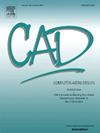Physically reliable 3D styled shape generation via structure-aware topology optimization in unified latent space
IF 3.1
3区 计算机科学
Q2 COMPUTER SCIENCE, SOFTWARE ENGINEERING
引用次数: 0
Abstract
We propose a novel approach to structure-aware topology optimization (SATO) to generate physically plausible multi-component structures with diverse stylistic variations. Traditional TO methods often operate within a discrete voxel-defined design space, overlooking the underlying structure-aware, which limits their ability to accommodate stylistic design preferences. Our approach leverages variational autoencoders (VAEs) to encode both geometries and corresponding structures into a unified latent space, capturing part arrangement features. The design target is carefully formulated as a topology optimization problem taking the VAE code as design variables under physical constraints, and solved numerically via analyzing the associated sensitivity with respect to the VAE variables. Our numerical examples demonstrate the ability to generate lightweight structures that balance geometric plausibility and structural performance with much enhanced stiffness that outperforms existing generative techniques. The method also enables the generation of diverse and reliable designs, maintaining structural integrity throughout, via a direct smooth interpolation between the optimized designs. The findings highlight the potential of our approach to bridge the gap between generative design and physics-based optimization by incorporating deep learning techniques.
通过统一潜在空间的结构感知拓扑优化生成物理可靠的三维样式形状
我们提出了一种结构感知拓扑优化(SATO)的新方法,以生成具有不同风格变化的物理上合理的多组分结构。传统的TO方法通常在离散的体素定义的设计空间中运行,忽略了底层的结构感知,这限制了它们适应风格设计偏好的能力。我们的方法利用变分自编码器(VAEs)将几何形状和相应结构编码到统一的潜在空间中,捕获零件排列特征。将设计目标细致地表述为物理约束下以VAE代码为设计变量的拓扑优化问题,并通过分析与VAE变量相关的灵敏度进行数值求解。我们的数值示例证明了生成轻量化结构的能力,该结构能够平衡几何合理性和结构性能,并且大大增强了刚度,优于现有的生成技术。该方法还可以生成多样化和可靠的设计,通过优化设计之间的直接平滑插值,始终保持结构的完整性。研究结果强调了我们的方法的潜力,通过结合深度学习技术,弥合生成设计和基于物理的优化之间的差距。
本文章由计算机程序翻译,如有差异,请以英文原文为准。
求助全文
约1分钟内获得全文
求助全文
来源期刊

Computer-Aided Design
工程技术-计算机:软件工程
CiteScore
5.50
自引率
4.70%
发文量
117
审稿时长
4.2 months
期刊介绍:
Computer-Aided Design is a leading international journal that provides academia and industry with key papers on research and developments in the application of computers to design.
Computer-Aided Design invites papers reporting new research, as well as novel or particularly significant applications, within a wide range of topics, spanning all stages of design process from concept creation to manufacture and beyond.
 求助内容:
求助内容: 应助结果提醒方式:
应助结果提醒方式:


